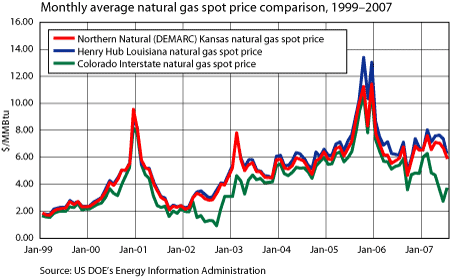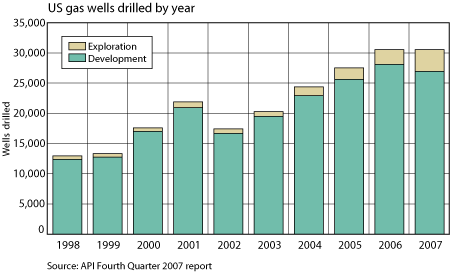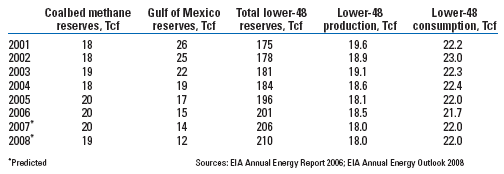Leonard Parent, Contributing Editor
Natural gas prices rose steeply last year, and that won’t be the end of it. Look for more of the same this year, at least until the players figure out why demand isn’t keeping pace, and what they can do about it. The best guess at this point is for $7-plus/MMBtu at Henry Hub, with some random pushes into $8 territory.
Everything costs more these days, and that includes the cost of moving gas from the wellhead to the burner tip. We have a free-market system, and price movement goes with the territory. Lately it’s all been up, and higher prices to end users are not conducive to building demand. US imports from Canada will likely fall if for no other reason than increases in home-grown Canadian demand, which will have to come first, especially in light of falling domestic production there.
PRICE
Spot gas prices in the Rocky Mountain states are usually close to those at the Northern Natural Gas Demarcation point in Kansas and at Louisiana’s Henry Hub, but saw large drops relative to those prices in late 2002 to early 2003 and again in late 2006 to the present. These price collapses can be attributed to pipeline maintenance and to reduced local demand due to mild weather, Fig. 1.
|

|
|
Fig. 1. Spot gas prices usually stay relatively close across the US, but recent years have seen prices fall in the Rocky Mountain states relative to other regions.
|
|
Gas prices will rise in 2008, reflecting increased production costs and supported by higher oil prices. As we watched, a cadre of players has pushed the price of oil to the $100 mark and seeks to make a long-term home for it there in 2008. Applying the old rule of thumb of a 6:1 relationship between oil and gas prices yields a mind-boggling prediction of $15 gas. Even under a 10:1 relationship, which some forecasters suggest should be the new rule, gas prices would be pretty hefty.
This promises to be a political year like no other, and that creates an opportunity for leaders to emerge who will connect energy policies with consumer interests, which would be a much-needed departure from the government track.
SUPPLY SIDE
The US gas resource base has gotten bigger, again. The Potential Gas Committee, in its biennial report, projects in situ US natural gas resources of 1,525 Tcf as of year-end 2006.
Much of the resource growth comes from new developments in the ability to produce gas from shale and coalbeds. Coalbed methane has been a life saver. Operators in Wyoming and a few other places have been drilling up a storm, making the difference between having supply come up short and staying in the game. We always knew it was there, but just couldn’t afford to go after it. Fortunately, with a combination of higher prices and some remarkable technological gains, we are doing it.
The gas supply system couldn’t cut it without storage. Local distributors began storing gas on off-peak days to use in colder weather during World War II, but operators didn’t really get with the program until about 50 years ago, when they concluded that storage was a sound economic choice compared with adding pipeline capacity to meet seasonal demand variations. Today, operators are finding still more ways that storage makes their supply systems more effective and efficient. There are about 400 active underground storage facilities in the lower 48 states. Additions to capacity are certain to increase as LNG deliveries multiply and as the market for gas-fired electric generation continues to grow.
RESERVES
The people in the know are coming around to a view that gas production isn’t going to change much, no matter how many wells we drill. Put another way, we must come up with new alternatives-the sooner, the better. Maybe, with a little luck, technology will rise to the occasion at least one more time.
At the end of 2006, the US Department of Energy’s Energy Information Administration (EIA) reported that Lower-48 proved reserves were up to 201 Tcf. Not surprising, considering the record-setting rate of completions that year. Given last year’s number of wells drilled, which remained essentially flat at about 30,600 but included more exploration wells (Fig. 2), the reserves number could very well be 210 Tcf as of year-end 2007. But it doesn’t look like 2008 will add as much to the reserves base. The Baker Hughes gas well rig count seems to have reached a plateau late last year, meaning that completions likely will follow suit. But at 1,400-plus operating rigs, the production outlook for gas users is still pretty good, Table 1.
|

|
|
Fig. 2. After seeing steady growth since 2002, gas drilling in the US leveled off in 2007. The percentage of exploration wells jumped to 12% from 8% in 2006.
|
|
| Table 1. US gas statistics and forecast, 2001 to 2008 |
 |
|
PRODUCTION
The good news is that onshore production is growing. The bad news is that production from the Gulf of Mexico is likely to continue to decline, but not as sharply as expected earlier, offset by increases from deepwater development including 850 MMcfd from Independence Hub. High deliverability from offshore is crucial for supplying Eastern markets.
If it were not for coalbed methane and Devonian shale, the production outlook would be bleak indeed. The US is becoming more reliant on LNG imports, which puts the country into a competitive world market for gas supply. There are a lot of other players out there who are likely to have their own rules, which may well be different from ours, on matters such as pricing.
PIPELINE PROJECTS
A number of recent and upcoming pipeline construction projects in the US are opening up new markets to previously remote gas plays.
Service began Jan. 12, 2008, on the western part of the Rockies Express Pipeline, a joint venture of Kinder Morgan, Sempra Pipelines and Storage, and ConocoPhillips. When completed, the pipeline will stretch 1,678 mi from Colorado to Ohio-making it one of the longest gas pipelines to be constructed in North America-and will have a capacity of about 1.8 Bcfd. The operational section of Rockies Express West (REX-West) stretches 500 mi from the Cheyenne Hub in Weld County, Colo., to the ANR delivery point in Brown County, Kansas., and has a 1.4-Bcfd capacity. The remaining 213 mi. section of the 42-in. REX-West will continue east to Audrain County, Mo., and is scheduled to come online in February 2008. Construction on the $4.5 billion, 639-mi REX-East pipeline to Ohio is scheduled to begin in the coming months, with interim service expected beginning in December, and full service in June 2009.
The Piceance Creek Gathering System, a 48-mile, 36-in.-diameter pipeline winding though the heart of the Piceance Basin, began transporting initial volumes of 300 MMcfd in January 2007. The Enterprise-owned, 1.6-Bcfd pipeline extends from a connection with EnCana’s Great Divide Gathering System near Parachute, Colo., north to Enterprise’s newly operational Meeker gas processing complex. Connectivity to the Great Divide system gives the Piceance Creek pipeline access to gas production from the southern portion of the Piceance Basin, including EnCana’s Mamm Creek Field.
The 134-mi., 24-in. Independence Trail subsea pipeline began operations in July 2007, carrying gas from the massive Independence Hub development in the Gulf of Mexico to the Tennessee Gas Pipeline for delivery to shore. The Independence project reached its peak production of 1 Bcfd in December 2007.
ALASKA
The concept of a pipeline to bring gas from Alaska’s North Slope to the Lower 48 is the industry’s version of a “pipedream.” Alaska’s major oil producers have been on this kick for more than 30 years, and have yet to lay one mile of pipe. Meanwhile, the gas continues to be reinjected year after year.
In 2006, then-Gov. Frank Murkowski worked out an incentive plan with the three largest producers of Alaskan oil-ConocoPhillips, ExxonMobil and BP-in which the state would tax the gas based on profits rather than production. The deal was intended as an incentive for the companies to build the pipeline, which could cost $20-$30 billion. That plan foundered largely due to a demand by the producers that oil and gas taxes be fixed for up to 45 years.
The current governor, Sarah Palin, has brushed off a ConocoPhillips proposal that calls for a somewhat reduced, 25-year tax freeze, a demand one state senator has compared to consumers asking for 25 years of certainty about gasoline prices at the pump.
Palin pushed the Alaska Gasoline Inducement Act through the legislature last year to encourage competitive bids on the project from companies other than the “big three” and to improve the state’s negotiating position. She may have found her perfect candidate in Calgary-based Trans-Canada, whose $26 billion proposal is currently under review. The Trans-Canada pipeline would move gas to the company’s hub in Calgary, which connects to the continent’s major markets, starting as early as 2017.
Meanwhile, ConocoPhillips has begun a marketing blitz aimed at scuttling the deal by convincing Alaskans that the project can only succeed with the leadership of a major producer of North Slope oil. State lawmakers plan to hold hearings in the coming months on this and other pipeline plans.
DEMAND
Demand was up in 2007, but not enough to get excited about. Look for more of the same in 2008. Demand isn’t what it used to be. In fact, it hasn’t changed all that much from 1972, but just about everything else has grown, from population to production.
Once upon a time, forecasts of gas consumption by basic industries tracked rates of industrial production. Scratch that one. Operators have been able to use technology gains to reduce energy consumption. Also, as the cost of gas rises, the economics of using otherwise unused internal resources is catching on, particularly in the refining sector, where refiners are consuming more “still gas.” In effect, the refineries are making and/or capturing more of their own fuel and have less need for natural gas. There has also been a decline in production of iron and steel from traditional blast furnaces, which use natural gas for fuel.
Manufacturers are also increasingly moving offshore to make goods, using cheaper labor and gas available outside the US. In particular, the offshore migration of producers of anhydrous ammonia and ammonia-based fertilizers has hurt US gas demand.
Then there’s residential consumption. How is it that the housing stock grows at about 1% per year, mostly heated by gas, yet gas consumption actually decreases. For example, the EIA reported that residential consumption in 2006 was 4,475 trillion Btu, while in 1977, 30 years ago, the EIA report shows residential consumption to have been 4,913 TBtu. According to my compound interest table, 1% per year, compounded over 30 years, suggests that consumption would have grown by more than 30%. What happened? It’s called conservation and improved thermal efficiency.
The industry is still waiting for gas-fired electric generation demand to take off and shore up residential demand. A carbon cap-and-trade law, such as that in the Lieberman-Warner bill now working its way through the Senate, could give gas-fired electric the push it needs to move from the margins to the mainstream.
LNG
LNG imports have turned downward in recent months, largely due to problems at the production and liquefaction end of the supply chain. More significantly, there’s the worldwide demand situation, which never used to have much effect on US supply. It seems that other countries are getting into the action. Buyers elsewhere have indicated a willingness to pay more for LNG cargoes than US buyers.
Where do we go from here? There are more players than ever before, and prices are higher, with little likelihood of backing down anytime soon. Inasmuch as LNG comes in big packages-about 3 Tcf per boatload-storage becomes an issue, as do terminal siting, pipeline capacity and available injection and withdrawal rates.
CANADA
Canada has in the past exported more than half of its gas production to US markets. This pattern is likely to change, if for no other reason than more gas will be consumed in Canada as the economy grows. The short-term demand growth for gas is 1.8% per year. Another reason is that Canada’s rapidly growing oil sands development consumes a large amount of gas. Finally, the rapid fall of the US dollar relative to the Canadian dollar means that gas exported to the US brings back a lot less money for Canadian gas producers.
The 2006 slowdown in Canadian gas well drilling is expected to result in declining production for 2008 and beyond. The consensus is that there are adequate energy supplies to deal with Canadian needs. As demand in Canada increases, growing the export market will take a back seat to meeting local increases in consumption.
However, Canada has the option of developing gas projects in the Northern Frontier lands. If and when a pipeline is built to deliver gas from the Mackenzie Delta to Alberta, it will bring some relief for Canadian users, though it is not likely that much of that gas will get south of the 49th parallel. Then there’s Nova Scotia production, which helps, but not to the extent anticipated a while back. The Deep Panuke discovery finally received the go-ahead from governmental officials and from EnCana’s board. Production is scheduled to begin in late 2010.
BEYOND THE HORIZON
Researchers say that more than half of all the organic carbon on earth is in the form of marine and permafrost hydrate deposits. Running out the world numbers tells us that it all adds up to more than 700,000 Tcf of methane. The US slice of the worldwide offshore pie nets out to more than 100,000 Tcf. That number offers the tantalizing prospect of more than 1,000 years of supply. However, the pace of research into how to access all that trapped methane has been agonizingly slow. Hydrates just aren’t ready for prime time.
ADDING IT ALL UP
The gas business is alive and well. Drilling and exploration activities continue to achieve new records. Reserve additions continue to build the proved reserve base, more than offsetting annual production. New pipeline capacity is in the works to move Rocky Mountain gas to Midwest and Eastern markets, easing the price pressure on buyers. Last year was a good year, and we expect more of the same in 2008.
In the longer run, the general consensus is that domestic production is at or near a peak, at least until such time as operators gain access to off-limits areas believed to hold substantial gas reserves. Overland imports from Canada are projected to decline, and the pipeline from Alaska remains a “pipedream” for the foreseeable future. Fortunately, the ramping up of LNG will tide the US over until we can get back in the exploration business in a big way. 
|
THE AUTHOR
|
|
|
Leonard Parent, a World Oil contributing editor, holds a BS degree in chemical engineering from Purdue University, and has been active in the gas business since 1950, beginning with Natural Gas Pipeline Co. of America. He later joined Trunkline Gas Co. in Houston and, in 1968, was appointed to corporate planning for Panhandle Eastern. Mr. Parent took early retirement after 26 years with Panhandle and Trunkline, and is publisher of The Gas Price Report and The Gas Price Index.
|
|
|






